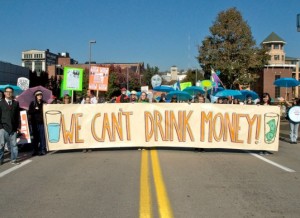A recent amendment to zoning legislation in the town of Dryden, NY has propelled the town of 15,000 up to New York State’s highest court and to the forefront of the anti-fracking cause.

Despite being banned in over 50 towns in New York State, few have been as strategic or promising for natural gas extraction as Dryden, which is situated on more than 141 trillion cubic feet of gas protected by the Marcellus Shale formation. The main group to attempt to seize on this opportunity has been Norse Energy Corporation USA, originally based in Norway, who is being represented as a plaintiff in the case to be tried at the New York State Court of Appeals.
The State of New York is currently under a five-year moratorium on fracking that was enacted by former Governor David Patterson in 2008 and extended indefinitely by current Governor Andrew Cuomo until further research by the State Health Department concludes. The moratorium also prohibits any lower-level activity which would interfere with state jurisdiction over the extraction process. While Norse Energy alleges that Dryden’s zoning changes intersects with state law, town residents state that the legislation merely prohibits “heavy industrial development” on land within the town and does not attempt to regulate the oil, gas, and mining industries. In addition to the nature of the changes, Dryden residents point out that the town’s decisions have been upheld by multiple lower-level courts in the state.
Aside from issues of jurisdiction, the consideration of a fracking ban involves careful weighting of environmental and economic consequences. Fracking involves the use of high-pressured water and chemicals to drill through deep rock formations and access deposits of natural gas, a process which brings the possibility of contamination of water supplies and other public infrastructure, as well as destruction of farmland. However, the approval of fracking activities in Dryden would open up to 18,000 wells for drilling, bring thousands of new jobs in the industry to the area, and promote energy independence.
Dryden’s case with Norse Energy is not the town’s first on the matter of fracking. 2012 saw a lawsuit with Anschutz Exploration Corp., in which Cortland County Court upheld the town’s zoning ban. Another case was resolved similarly in the same month, with Middlefield, another town west of Dryden, maintaining its anti-fracking activities in a case against a dairy farmer in the area who had contracted with Elexco Land Services, Inc. to seek out natural gas resources on her property.
Fracking, with its array of benefits and detriments, remains a polarized issue. A recent poll conducted by Siena College showed a 43 percent opposition to the drilling, while 38 percent expressed approval.

I’d like to comment on the statement, “Fracking involves the use of high-pressured water and chemicals to drill through deep rock formations”.
Hydraulic fracturing is a stimulation technique that is performed on wells after the well is drilled, cased, cemented, and perforated. “Fracking” does not have anything to do with the drilling process, and is not even conducted by drilling engineers.
Here’s how the process works:
Fluid at a pressure above the fracture pressure of the formation is injected into the cased and cemented well.
The fluid passes through holes in the casing, and pushes apart the formation (this is the fracture). This fracture propagates until it reaches a ductile sedimentary layer, which may only be inches thick.
This fluid is followed by the frac slurry (water, chemicals, and proppant) that will flow into the newly created fracture to hold it open after pressure is released at the surface. Any part of the fracture that is not “propped” will be closed and sealed by the overburden stress of the sedimentary rocks above it.
Pressure exponentially decreases as a function of radial distance from the well bore. It is very difficult to get fractures on the scale of even 500′ tall, and even more difficult to prop the fractures open after they are created.